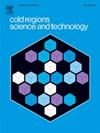Retrieving snow depth distribution by downscaling ERA5 Reanalysis with ICESat-2 laser altimetry
IF 3.8
2区 工程技术
Q1 ENGINEERING, CIVIL
引用次数: 0
Abstract
Estimating the variability of snow depth in remote areas poses significant challenges due to limited spatial and temporal data availability. This study uses snow depth measurements from the ICESat-2 satellite laser altimeter, which are sparse in both space and time, and incorporates them with climate reanalysis data into a downscaling-calibration scheme to produce monthly gridded snow depth maps at microscale (10 m). Snow surface elevation measurements from ICESat-2 along profiles are compared to a digital elevation model to determine snow depth at each point. To efficiently turn sparse measurements into snow depth maps, a regression model is fitted to establish a relationship between the retrieved snow depth and the corresponding ERA5 Land snow depth. This relationship, referred to as subgrid variability, is then applied to downscale the monthly ERA5 Land snow depth data. The method can provide timeseries of monthly snow depth maps for the entire ERA5 time range (since 1950). We observe that the generic output should be calibrated by a small number of localized control points from a one-time field survey to reproduce the full snow depth patterns. Results show that snow depth prediction achieved a model fit value of 0.81 (post-calibration) at an intermediate scale (100 m × 500 m) using datasets from airborne laser scanning (ALS) in the Hardangervidda region of southern Norway, with still good results at microscale ( 0.34, RMSE 1.28 m, post-calibration). Bias is greatest for extremes, with very high/low snow depths being under- and overestimated, respectively. Modeled snow depth time series at the site level have a slightly smaller RMSE than ERA5 Land data, but are still consistently biased compared to measurements from meteorological stations. Despite such localized bias and a tendency towards average snow depths the model reproduces the relative snow distribution pattern very accurately, both for peak snow (Spearman’s 0.77) and patchy snow meltout in late spring (Matthews correlation coefficient 0.35). The method relies on globally available data and is applicable to other snow regions above the treeline. Though requiring area-specific calibration, our approach has the potential to provide snow depth maps in areas where no such data exist and can be used to extrapolate existing snow surveys in time and over larger areas. With this, it can offer valuable input data for hydrological, ecological or permafrost modeling tasks.
基于ICESat-2激光测高的ERA5降尺度再分析反演雪深分布
由于可获得的时空数据有限,估算偏远地区雪深的变异性面临重大挑战。本研究使用ICESat-2卫星激光高度计的雪深测量值,这些测量值在空间和时间上都是稀疏的,并将它们与气候再分析数据结合到一个降尺度校准方案中,以产生微尺度(10米)的每月网格化雪深图。将ICESat-2沿剖面的雪面高程测量值与数字高程模型进行比较,以确定每个点的雪深。为了有效地将稀疏测量值转化为雪深图,拟合回归模型,建立反演雪深与ERA5陆地雪深之间的关系。这种关系被称为子网格变率,然后应用于每月ERA5陆地雪深数据的降尺度。该方法可以提供整个ERA5时间范围(1950年以来)的月雪深图时间序列。我们观察到,一般的输出应该通过一次性实地调查的少数局部控制点来校准,以重现完整的雪深模式。结果表明:利用挪威南部Hardangervidda地区机载激光扫描(ALS)数据,在中尺度(100 m × 500 m)预测雪深的R2模型拟合值为0.81(定标后),在微尺度(R2为0.34,RMSE为1.28 m,定标后)仍有较好的结果。在极端情况下,偏差最大,过高或过低的雪深分别被低估和高估。在站点水平上模拟的雪深时间序列的RMSE略小于ERA5陆地数据,但与气象站的测量结果相比仍然存在偏差。尽管存在这种局部偏差和平均雪深的趋势,但该模型非常准确地再现了相对雪分布模式,无论是峰值雪(斯皮尔曼ρ 0.77)还是晚春的零星雪融化(马修斯相关系数0.35)。该方法依赖于全球可用数据,适用于树线以上的其他雪区。虽然需要特定区域的校准,但我们的方法有可能在没有此类数据存在的地区提供雪深图,并可用于在时间和更大范围内推断现有的积雪调查。有了这个,它可以为水文、生态或永久冻土建模任务提供有价值的输入数据。
本文章由计算机程序翻译,如有差异,请以英文原文为准。
求助全文
约1分钟内获得全文
求助全文
来源期刊

Cold Regions Science and Technology
工程技术-地球科学综合
CiteScore
7.40
自引率
12.20%
发文量
209
审稿时长
4.9 months
期刊介绍:
Cold Regions Science and Technology is an international journal dealing with the science and technical problems of cold environments in both the polar regions and more temperate locations. It includes fundamental aspects of cryospheric sciences which have applications for cold regions problems as well as engineering topics which relate to the cryosphere.
Emphasis is given to applied science with broad coverage of the physical and mechanical aspects of ice (including glaciers and sea ice), snow and snow avalanches, ice-water systems, ice-bonded soils and permafrost.
Relevant aspects of Earth science, materials science, offshore and river ice engineering are also of primary interest. These include icing of ships and structures as well as trafficability in cold environments. Technological advances for cold regions in research, development, and engineering practice are relevant to the journal. Theoretical papers must include a detailed discussion of the potential application of the theory to address cold regions problems. The journal serves a wide range of specialists, providing a medium for interdisciplinary communication and a convenient source of reference.
 求助内容:
求助内容: 应助结果提醒方式:
应助结果提醒方式:


